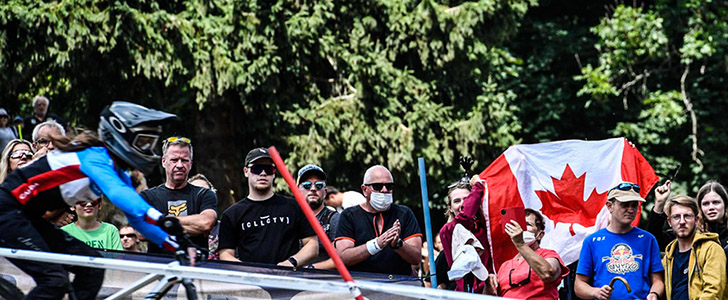January 9/13 13:13 pm - 1974 Raleigh Professional Restoration - You CAN Go Back
Posted by Editoress on 01/9/13
Early in 2012 we received a press release from Raleigh, reminding us that it was the 125th anniversary of the brand, a very impressive number. And, it also got me to thinking about some of the glory days for Raleigh, back in the 1970s when the T.I. Raleigh professional road squad run by Peter Post was one of the most dominant in the peloton.
In the early 70s was when I was getting involved with racing, and Raleigh was one of the most respected racing brands in the world. It was part of a merged British cycling conglomerate that also owned Tubes International (the 'T.I.' part), Brooks saddles, Sturmey Archer, Reynolds tubing and Carlton, a high end custom racing frame builder based in Worksop. It was one of the most vertically integrated bicycle companies the industry has ever known.
Riders such as Hennie Kuiper, Gerrie Knetemann, Jan Raas and Joop Zoetemelk all rode for Post and the T.I. Raleigh squad. In the 1980 Tour de France the team won 11 stages and Zoetemelk won the Tour overall.
Catalogue
Anyway, when I was a young, aspiring racer, one of the bikes I would drool over was the Raleigh Professional. It was built from Reynolds 531 tubing and fully spec'd with Campagnolo Nuovo Record, and came in a beautiful understated mink blue with silver and gold accenting. This wasn't just a looker, it was a full on racing bike but, at a staggering $600-plus, completely unattainable for a teenage racer with a part time job that paid a buck-sixty an hour... Instead, I ended up with a used Carlton (from before they became Raleigh's high-end department) as my first 'real' bike, built up with a cobbled together collection of parts.
Interestingly, Raleigh Canada re-introduced for 2012 a new version of one of their classic steel models - the International (the model below the Professional) - hand-welded in Reynolds 853 chromoly steel with chromed lugs and Shimano Dura Ace components.
So, as I'm reading the Raleigh 125th anniversary notice, I naturally start reminiscing about one of the fantasy of my youth. Just out of interest, I did a quick eBay search for "Raleigh Professional" and up pops "1974 Raleigh Professional Mk IV". It's been sitting in a garage for 20 years in Jupiter, Florida, and IT'S MY SIZE!
I let it mull around in my head for a few hours, having an argument with myself that it doesn't make sense, and then I contacted James Stefanuk at Raleigh Canada and Noah Rosen at VéloColour: Would either be interested in participating in a restoration project? Noah could show off his refinishing skills, and Raleigh could help with things like period decals, etc., as well as display the bike in their booth for the Canadian trade show.
Within 24 hours both came back with an enthusiastic yes and, as simply as that, we were underway.
It's a project that more than one longtime rider has considered: the restoration of a much beloved older bike. Maybe it is the bike you first began seriously riding on, or (as in this case) a bike you couldn't afford in the past. The question is: Is it feasible to restore such a bike and how difficult (and expensive) is it?
In this case, we weren't sure what we were going to be dealing with until the bike landed on my doorstep a few weeks later - what sort of shape would it be in? Did it have most of the original parts, was there frame damage? All of these questions would affect the project.
Luckily for us, the bike was in near-stock condition, just as advertised. Of course, there were a few things that had worn out and been replaced over the years - rotting brake lever hoods, tires, cables and handlebar tape - but, in general, it was in pretty good shape. Photo gallery of bike before the restoration
The paint was faded and chipped in places, the chromed bottom halves of the fork blades and rear stays were pitted (as one might expect from the salt air in Florida), and everything was coated in a miasma of dirt, dust and neglect, but there was, thankfully, no serious structural damage to the frame or fork, nor had it been stripped of original components.
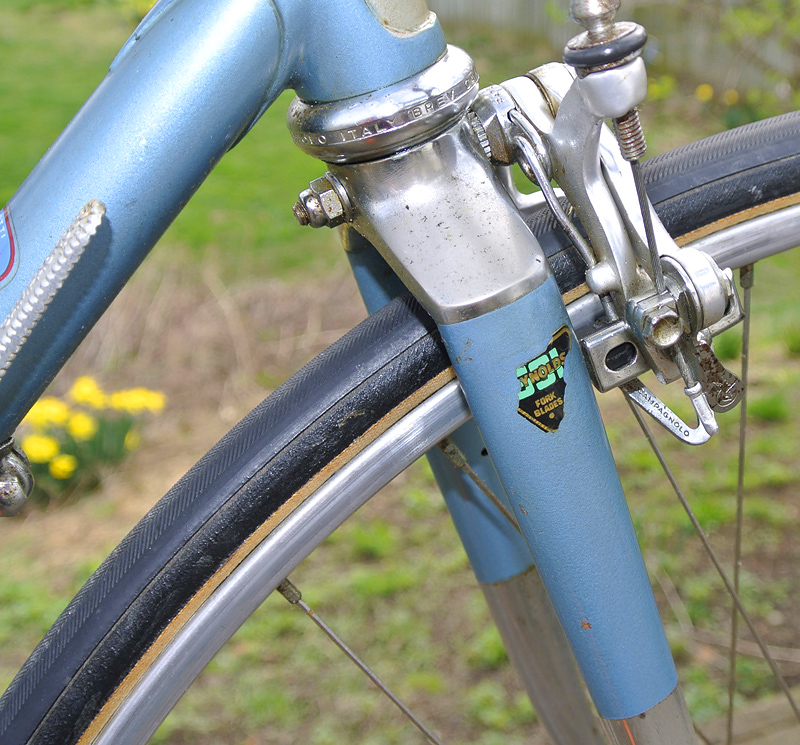
The paint was scratched, the chrome was quite pitted, decals torn or missing, components rusted
I arranged to meet with Noah at his workshop in east Toronto to drop off the bike for his inspection and determination of the next steps. We have interviewed and written about Noah and his company VéloColour before - first at the North American Handbuilt Bicycle Show (NAHBS) in 2010 (see NAHBS 2010 Interviews ), where he had won the Best Painter award a year earlier and, more recently at the La Bicicletta One-of-a-Kind Christmas Show (see One-of-a-Kind).
Noah comes from a Fine Arts background, and worked with Mike Barry at Mariposa Bikes for a few years before setting up his own business. Noah does both restorations and custom paint jobs on newer bikes. He is meticulous in researching the proper colour schemes and decals for older bikes, and says that it makes up more than 50% of his business.
Noah actually shares workshop space with Mike Barry of Bicycle Specialties, who closed his storefront a few years ago, but still keeps his hand in with restoration work. Serendipitously, Mike was actually there when I brought the Raleigh, and subsequently agreed to participate in the restoration - a link back to a shop owner who had actually sold this model when it was new!
The actual restoration took approximately four months - mainly because Noah is so busy, and it had to fit into his schedule with other jobs. During that time, we kept in contact as questions came up, and there was one major one: the chrome.
In those days (1960s and 70s), many higher end bikes had chrome highlights - particularly on the stays, dropouts, the bottom of the fork blades, fork crown, lugs and end caps of the seat stays. Now, we point to the extra weight, but it was the style of the time.
The Raleigh Professional Mk IV came with half-chromed stays (seat and chain), a half-chromed fork and a chromed Cinelli sloping fork crown - still one of the most beautiful looking forks going, in my opinion.
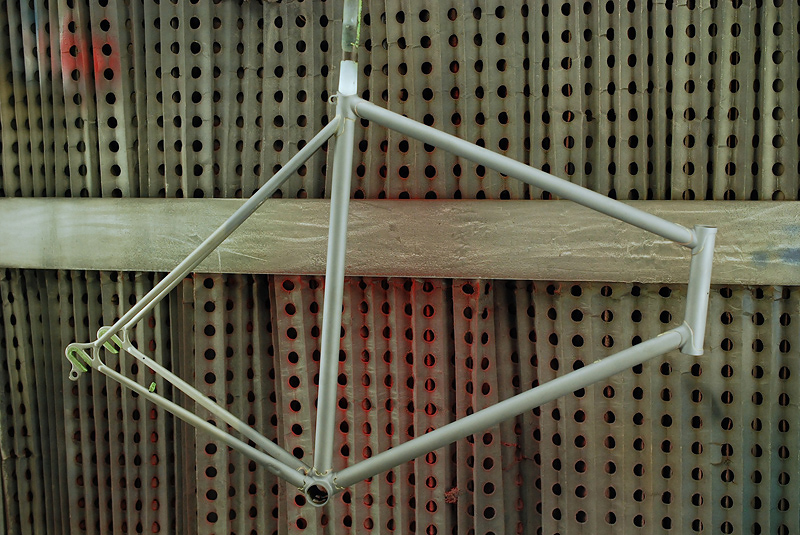
The frame: Sandblasted and cleaned
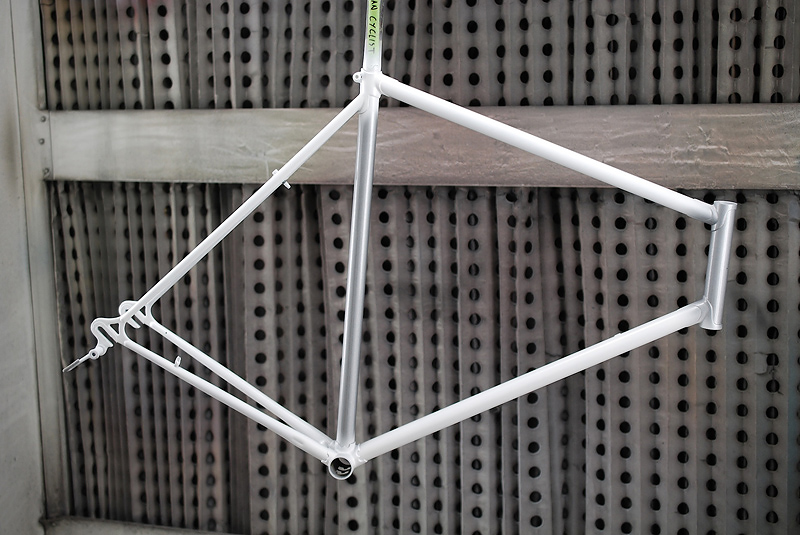
Reprimed, silver panels painted
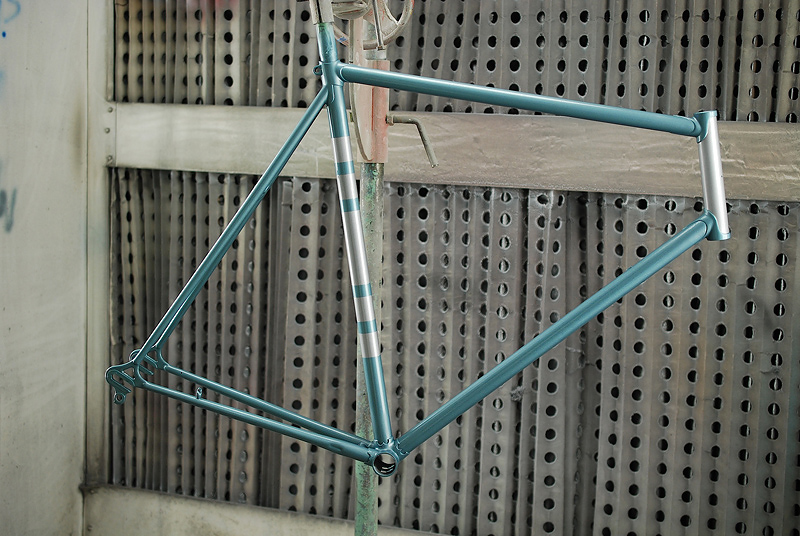
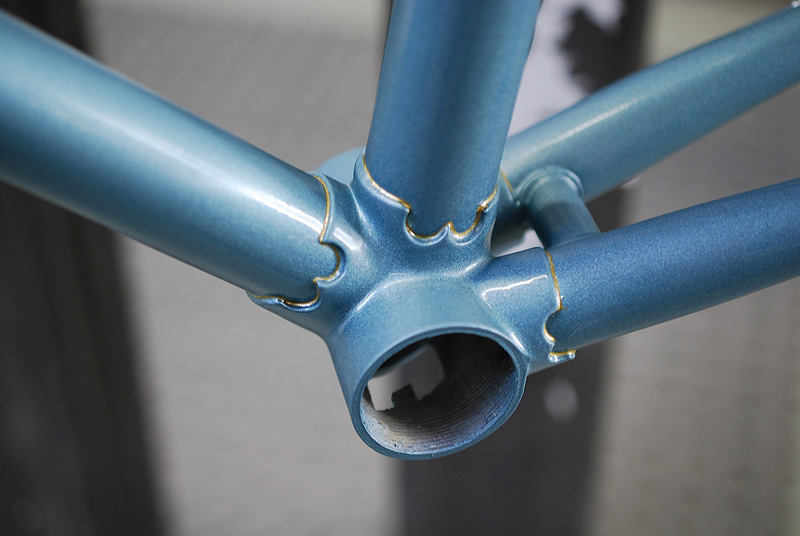
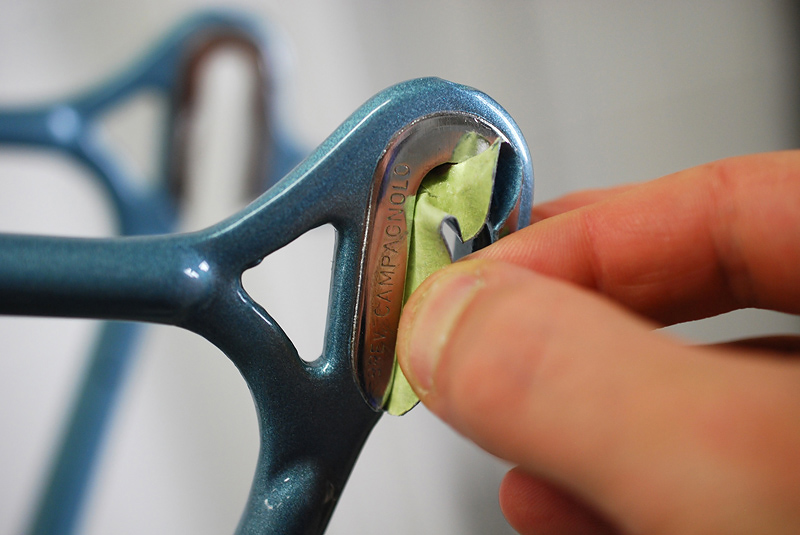
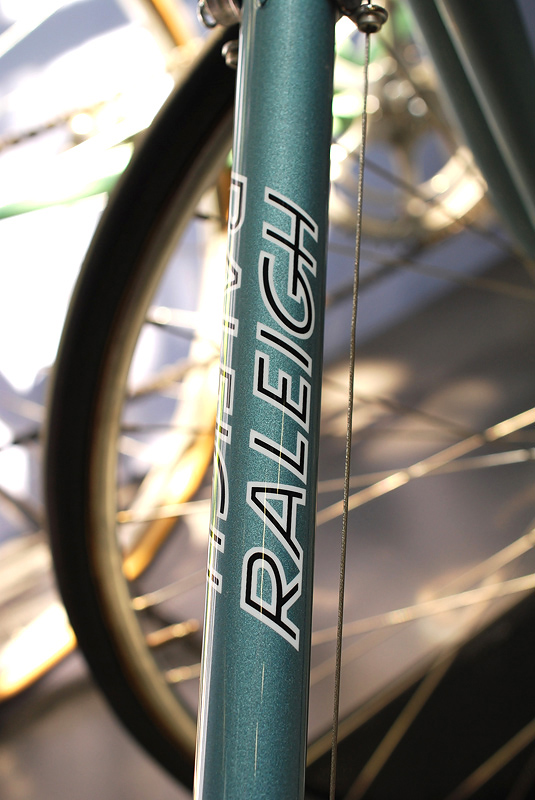 Noah had warned me that we would have to make a decision about the chrome - he felt in his initial inspection that it was too damaged to not require redoing. After the paint had been stripped, Noah gave me the expected bad news: the chrome would either have to be redone, or we would need to go to straight paint, eschewing any chrome highlights.
Noah had warned me that we would have to make a decision about the chrome - he felt in his initial inspection that it was too damaged to not require redoing. After the paint had been stripped, Noah gave me the expected bad news: the chrome would either have to be redone, or we would need to go to straight paint, eschewing any chrome highlights.
Noah has a chrome shop that he works with, but the cost was significant, adding another 50% to the price. I really struggled with this one; while I wanted to have the Raleigh as original as possible, it would increase the cost well beyond what was budgeted. In the end, I decided to forego the chrome. My rational was, that this was meant to be a working bike, not a wall hanging.
Photo gallery of the stages of the restoration
After Noah finished the painting, it was turned over to Mike for the rebuild. Mike made the following comments:
"I have tried to get the bike back to its original condition, but a few items were not possible. Originally the brake lever rubber hoods would have been gum. These are now very hard to find, [so] I have installed NOS white ones. The saddle that came with the bike is a Brooks B17 standard. The original would have been a Brooks Professional [Note: I happened to have one, already broken in]."
"The freewheel that came with the bike is a 6 speed 14-28. The original would have been 14-24. Consequently, the rear derailleur is at its limit and does not work as well as I would like."
"The tires have black walls. The original would have had gum walls. Where possible I have replaced rusted screws, etc. Some brake parts which are rusty I had no replacements available [for]."
"I think the bike looks pretty good. Not quite as it did when new in 1974, but not too far off."
So, when all was said and done, the Raleigh was restored to nearly original condition.
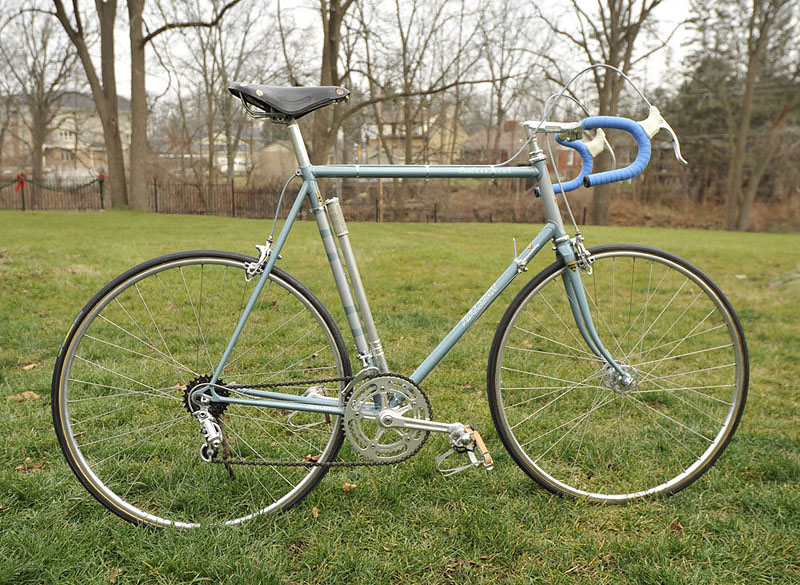
Restored bike
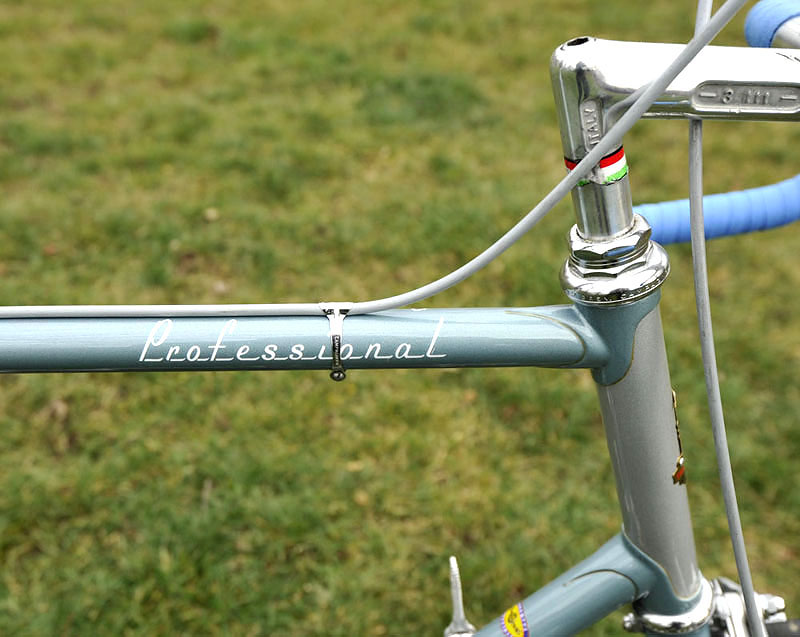
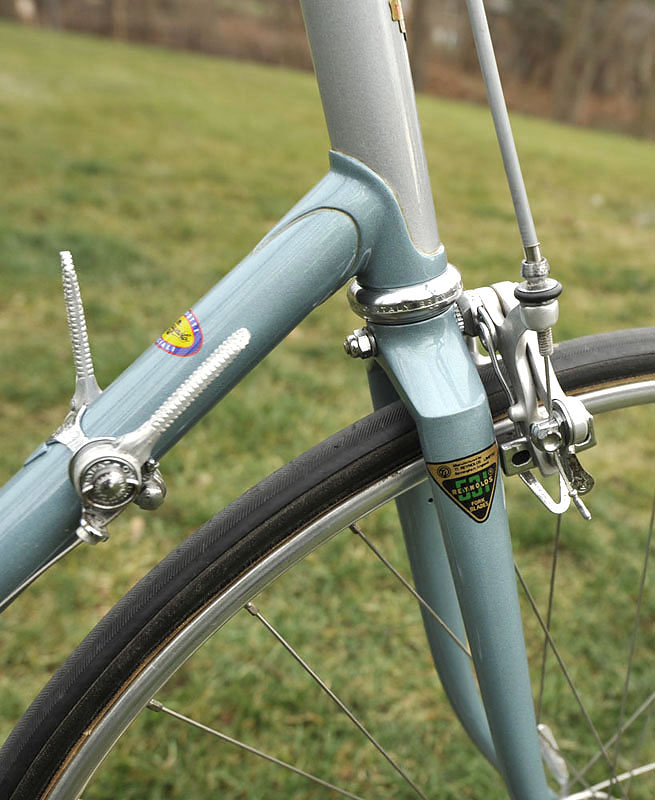
Photo gallery of restored bike
It was finished while I was (of course) on the road. Tracy picked it up and delivered it to Raleigh Canada to place in their booth for the ExpoCycle trade show, where it was reported to have made a big impact, drawing dealers and other members of the industry into the Raleigh booth to both admire and do their own reminiscing.
Finally, I was able to pick up the bike and look at the finished project for myself. I have to say, that there is still something about a steel, lugged bike that is special. The thin steel tubes, with their Spearpoint Latin Line lugs tapering into the 531 tubes, outlined in gold, looked elegant and appropriately proportioned, while the fastback seatstay cluster contributes to the minimalist design.
The frame looks considerably more 'laid back' than current geometries, and the rake on the fork looks enormous, compared to the straight blade, oversized carbon we see on new bikes. However, the Raleigh Pro was considered one of the stiffer bikes of its era - a bonus for the 61 cm size I need.
Of course, one of the most noticeable differences between a 38 year old bike and a new one comes the first time you pick it up. One of the recent bikes I have been riding is a 17 pound all carbon beauty with electronic shifting. The Raleigh Pro - one of the lighter bikes of its day - weighs in at 22.5 pounds ...
It comes with downtube friction shifters and pedals with toeclips. Instead of 20 gears (or 22), it has 12 - and it was one of the early models to go to a six-speed cluster (my Carlton at the time had 10 gears). However, the weight is only noticeable when compared to a new bike; back in its day other bikes were same weight or more, so there was no disadvantage.
So far, I've talked about everything but the ride. There was definitely some concerns. Would it be a big let down because of all the changes in technology in the intervening years? Could I still shift without the benefit of indexed shifting systems? Could I even fumble my feet into pedals with toeclips and straps without making an idiot of myself? Basically ... can you go back and recapture one of the dreams of your youth?
The Raleigh Pro and I went out for our first ride on one of my usual routes in the countryside where we live. It starts with a pretty flat road out of town before turning onto a long rolling section through farmland, with some sections of fairly rough pavement. Getting into the pedals took a bit of fumbling, but the shifting came back very quickly, and I was able to handle the first downshift on a climb - anticipate, back off the pressure slightly, overshift a bit and then snug it into the gear - with no clattering of gears and loss of power (muscle memory of thousands of kilometres).
Initially, looking down and seeing those skinny steel tubes was a bit disconcerting. I also found that the move towards wider bars over the years is something I definitely approve of - how did I ever manage with 38 cm wide bars!
The ride was what I remember best about steel: stiff without beating you up, lively without that dead feeling that some composite bikes have. It climbs solidly (albeit with a noticeable weight penalty), descends dependably and damps out the worst of the rougher sections of pavement. The slacker frame angles make it less twitchy in corners than a lot of newer bikes, which actually provides more confidence to carve through them.
This is an all-day rider; ironically, that is the new 'hot' style of bike these days, led by the category-defining Specialized Roubaix. What was old is now new again...
The Bottom Line
So, this brings us to the original question: Is it feasible to restore such a bike, and how difficult (and expensive) is it?
On the first part, the answer is clearly yes. Besides the sheer pleasure it generates in looking at one of the dreams of your past, it turns out that builders in those days really knew what they were doing (yes, that's a little bit of sarcasm). The Raleigh Pro could easily be a daily rider, although I'd likely install wider bars and maybe go to clipless pedals with newer shoes - old Detto Pietros do not hold up the same way as the bike does...
In terms of the difficulty of restoration, well, that is more complicated. Our Raleigh Pro was in pretty reasonable shape and had been stored well, with minimal changes to its original spec. Of course, pretty much anything can be restored given enough time and money, but this is something that requires a pragmatic and clear eye before you get too deep into the project. Someone like Mike Barry can tell you pretty quick what's likely to cause problems.
One question you need to ask yourself early in the process is, are you trying for an authentic, true to original spec restoration, or are you looking to get a older steed into fairly original condition? As I stated with this project, we had that question when it came to the chroming, and decided not to go to that level of verisimilitude. On the one hand, I would have liked to see the Pro back to its exact look, but the goal here was to get a bike that rode like the one I had wished for 38 years ago, and we accomplished that.
For our project, leaving aside the actual cost of the bike, the bill for Mike Barry's services in stripping down the bike, cleaning and repairing some parts, some replacement parts (such as the tape, tires, brake hoods, a pump clip, cables and casing, etc.) and then rebuilding the bike came to about $500 (parts and labour, before tax). Of course, you could absorb much of the labour cost by doing the work yourself (which I would have preferred to do, to be honest, but I was on the road for most of the season).
For Noah's work - stripping the old paint, prepping and repainting the frame and fork, applying period-correct decals, and all of the paint detailing - you really need to go to an expert. Noah estimates that he spent approximately 20 hours on this restoration, and the bill would be in the neighbourhood of $1100 (including paint, decals and labour, before tax).
According to the Bank of Canada, the 1974 new price of $625 equates to $2800 in 2012 dollars, and given the Raleigh Pro's standing in the market at the time, I would argue it is really comparable to a current $5000-$6000 bike. So for roughly 25% to 30% of the price of a new bike you have fulfilled a dream.
I would say that is a bargain.
We would like to thank the following for their assistance:
Raleigh Canada
VéloColour
Bicycle Specialties
| Return to Canadian Cyclist homepage | Back to Top |

